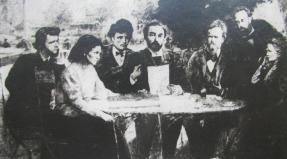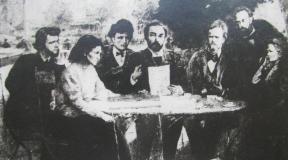Crafts from plastic bottles for home and garden, new photo ideas. Cat pots made from plastic bottles
For people with imagination and skillful hands, it will not be difficult to turn unnecessary things into real masterpieces. Masters and beginners use crafts from plastic bottles for the interior, as garden decor and in the form practical furniture. Colored plastic bottle caps are an excellent material for mosaic panels on walls and fences. Best ideas With detailed instructions and the photo can be easily implemented at the dacha, turning a bare area into a “clearing of fairy tales”, and filling the house with useful little things.
Important advantages of crafts made from plastic containers
A well-made souvenir or trinket will eventually develop into a hobby, if there are no limits to your imagination. Summer residents who have moved from simple fences on wire to buildings that delight in scale never cease to amaze.
From available material that many throw away, someone builds:
- greenhouse;
- carport;
- Summer shower or a bathhouse;
- country toilet or a shed;
- summer gazebo or sun visor;
- mansion for children or playground;
- sandbox with decorative sides;
- various temporary buildings on the site.

The main advantage of such structures is available material. When the elements are securely fastened, the walls of the building are aesthetically pleasing and completely reliable. It all depends on the way the plastic bottles are connected. If you approach the matter thoroughly, the desired result will impress even experienced builders.
Over time, plastic becomes a real environmental disaster - it is difficult to recycle. But once you involve everyone who cares in cleaning the area, there will be a whole mountain of empty PET bottles for building a greenhouse, cascading flower bed or vertical gardening. The only drawback is the long collection of identical containers, since the containers are produced different color and volume.
Some manage to collect enough craft material in one season, while others involve neighbors and friends in collecting plastic. Someone decides to clear the area for picnics in order to improve the environment on the way to the dacha and collect material. As a result, the plastic bottles are in use and the area is clean.
Another advantage - plastic container soft and pliable, easy to cut, no need to complex instruments. With little skill, the material itself “dictates” ideas.
For creating original decoration required:
- interesting idea;
- finished sample for imitation (illustration);
- material for crafts with tools;
- step by step guide training plan.
In the hands of a true master, plastic bottles take on a second life, becoming functional objects. It is better to make souvenirs on a seasonal basis. For example, New Year's toys crafts in winter, practical country houses- in the summer, and in the spring and autumn it remains to build a “clearing of fairy tales” near the house for the children.
Recycling of plastic containers – exciting activity for family. It is easy to attract children to him by entrusting him with a simple part of the work. Don’t forget to remind them that you’re not just making a firebird or “Chunga-Changa island” with palm trees from bottles, but that you care about the environment. You can involve a yard or a school classroom in beautifying the area.

Furniture and interior items made from plastic bottles
Furniture made from plastic bottles looks like a masterpiece that is not accessible to everyone. They will require a lot of plastic containers of the same type. Sofas and poufs impress with their design and comfort, not inferior to real furniture. There is nothing complicated if the sofa is made in blocks - seat, back, sides. If the container is not enough, the sofa blocks can be made one at a time. It’s better when you collect bottles from one drink, for example, two-liter kvass or lemonade.

The principle of “assembling” furniture from bottles is simple - they are placed in layers and tightly wrapped with tape. To make the furniture softer and more springy, a little air is released from each bottle and twisted tightly. At the place where the cap is, cut out a cap from another bottle and tape it with tape. It turns out to be a block with a bottom on both sides - this is the basis of the furniture.
Then it all depends on your imagination, the type of furniture and the number of bottles available. We wrapped 7 containers of the same volume with tape to create the base for an ottoman. What its appearance and style will be depends on the artist. For a soft seat you will need round pillow or a block of foam rubber to fit the top. The cover is cut to the size of the ottoman in the form of a cylinder, and it is convenient to insert a zipper along the side seams, but it is easier to sew the upholstery tightly.
If there is not enough furniture for the summer, an ottoman for the cottage is made from an old one. cotton blanket and a baby pillow, wrapping them around a block of bottles. Old curtains or a bedspread will be used for the lining. If the pouf should have a presentable appearance, choose newer and more expensive fabric or eco-leather.

For construction coffee table you will need 4 racks of plastic bottles and plywood board as a table top that can be hidden with a long tablecloth. In a similar way do convenient stand for a laptop or a remote table for the garden. For large furniture (sofa, chaise longue or chair) made from plastic bottles, you will need a lot of patience and raw material.

Useful little things for the home from plastic bottles
Flowers and vases
Decorating a schoolchild's bedroom or children's room with crafts from plastic containers is not difficult. You can build a whole bouquet of artificial flowers. Place the resulting chrysanthemums, daisies or roses in a vase made of the same material, adding diode bulbs on an insulated wire to the centers. This is what a night light of extraordinary beauty will look like, where the faint light shimmers in the plastic petals.
Advice: To give the leaves a special shape, use heating the blanks and folding the corners with tongs!
To place a homemade bouquet you will need a suitable vessel; simply cutting off part of the bottle is not aesthetically pleasing. The edges of the cut are marked with a ruler to make the cut, securing the result by heating the bends. A small transparent bottle is cut off to the very top, and about half of a large container is cut off. We choose a material with a ribbed or “waist” in the middle to create an interesting base.
Then we do it as our imagination allows, but we bend the edges beautifully. The fringed cut is obtained from vertical or diagonal cuts in the plastic base. The resulting strips are evenly folded onto outside.
Note! It is important that all the notches and the depth of the slot are absolutely identical, then the entire product will come out neat.
Depending on which edge is desired, the strips of the vase (the edges of any other product) are secured in different ways:
- curly bend;
- staplers;
- fusing;
- gluing with transparent polymers.




Flowerpots, flower pots and containers for seedlings
Colored plastic containers in the form of bottles and bottles of different sizes are suitable as containers for growing living plants. It’s very easy to make a fragrant balcony from 3-liter tanks - cascade hanging petunias. Fragrant flowers hanging from cut containers will help make your dream of a beautiful piece of paradise come true.
Large bottles and tanks cut in half are hung with both the bottom down and the lid. It is recommended to place large pebbles at the bottom for drainage. Excess water after watering will go to the plants in the lower rows. In the same containers, plants are grown without soil - hydroponic method with the addition of fertilizers. Fresh greens and seedlings (in urban and country conditions) are also germinated in prepared plastic bottles.
Advice: Use the compact form and ability to hang containers for vertical gardening with automatic watering. In the absence of the owners, watering cans with water immersed in the ground will cope with moistening the plants.


Traps and feeders
Using plastic bottles you can repel pests or attract birds to your site. For this purpose, the tank is used as a feeder, and at the roots fruit trees place traps from bottles of chemicals. From double plastic containers, craftsmen construct traps for wasps, where they fly into sweet water and can't get back.



Equipment for a summer cottage
At the dacha, it’s easy to whip up crafts from plastic bottles in the form of an impromptu washbasin by hanging a full bottle upside down. Just unscrew the lid a little and a small stream of water will help you wash your face and hands. It is also worth making a bench and organizing lighting with beautiful owls or plastic gnomes. Any garden decor for inspiration - with interesting illustrations.



Multifunctional items for the home
Make an original cosmetic bag from 2 bottoms of plastic bottles, sewing the edges together with a zipper. This box can be used as a multifunctional item - a piggy bank, a case for large beads, hairpins or jewelry.
It is convenient to knit from such a ball, suspended somewhere nearby, by pulling the thread from the ball inserted inside. It’s easier to find nail polish or a lipstick collection in a makeshift zippered box.

New Year's decor
Bright christmas balls, garlands or toys made from plastic bottles are a worthy use for transparent containers. One bottle, cut into round strips, will produce a transparent ball. After securing the sphere with a stapler, decorate it in any way:
- “rain” winding;
- pasting with crushed polystyrene foam (snow);
- decoration with sequins, beads and stones.
New Year's decor made from white plastic bottles with a waist is suitable for snowmen or penguins. You can use black nail polish to draw eyes and other elements, cotton wool (snowball), glitter, small buttons, beads and whatever is at hand. Funny caps for characters - from colored socks without a pair, strips of knitwear are used as a scarf.
Advice: From homemade winter characters, a candle, ready-made tinsel and a couple of pine branches with cones, create an original New Year's composition so as not to buy a Christmas tree.



Curtains made of colored plastic caps and bottles
Space zoning is popular design technique, where a do-it-yourself translucent curtain is often used. Original curtain can decorate any living space, cottage or covered terrace. Original hanging partitions made from unusual materials are widely used in the interior.
IN modern decor Plastic is in demand, including bottles and bottle caps. There are options for curtains:
- from scraps from the bottoms of small containers - strips on a thick fishing line, swaying with the movement of air;
- from colored lids - a fantasy panel of tightly strung elements;
- a garland of plastic and lights to give the LED curtain more aesthetics.

Original all-season flower beds
The summer season is passing, and living flower beds are being replaced by homemade plastic flowers that are no less beautiful than real ones. Their advantage is the ability to decorate the territory at any time. These flower beds pale in comparison to living plants, but in early spring And late autumn only they attract admiring glances.

For daisies you will need small ones plastic containers white (petals), yellow (centers) and green (leaves). You will also need an awl and a candle (for heating), “liquid nails,” scissors and stiff wire in green insulation.
We cut the base of the white bottle to the center, marking 16 segments - these are the petals. We bend the neat edges over the candle flame, and also make 2-3 chamomile corollas, which we connect in the center with an awl. Here the stem with leaves is fixed on a green wire, closing with the middle. We fill the center of the flower with a yellow basket with small cuts from 2 finely dissected circles with a fringe bent over the candle. We supplement the flower with green sepals from the bottom, collect all the parts and fix them together.

From the remaining pieces of green plastic, cut out leaves with a hole at the base (for stringing) and give them the desired shape, heating them over a candle flame. We attach the leaves to the wire handle; they should bend around it slightly. All that remains is for the chamomile to make several “companions” and find a worthy place for the bouquet.
Using samples and imagination, it’s easy to make plastic lilies of the valley, roses, chrysanthemums or tulips. This requires plastic. suitable color, from which several layers of petals are made to achieve a resemblance to real flowers.
All-season flower beds include mosaic compositions made from containers filled with earth. Made from lids wall panels. "Butterfly" or " ladybug» – in different versions.

Crafts from plastic bottles for the playground
An incredibly beautiful bird with plastic plumage – a whole “clearing of fairy tales”. These are the peacock or firebird, swans, pigeons, bullfinches and parrots. All of them are made from empty PET bottles according to the general principle:
- Design an aesthetic bird's head with eyes and beak;
- Construct the torso and neck;
- String plastic plumage;
- Provide with wings and tail;
- Place on paws or secure to selected surface.
Plastic swans can be fenced off by a blue “lake” of upside down plastic bottles. Outlandish birds will decorate the trees in the corner of the garden, which is reserved for children's games. You can choose a themed decor, for example, a desert island with palm trees and parrots.
Plastic animals, birds and insects, familiar to our latitudes, as well as favorite fairy-tale characters, are supplemented with other materials. Tires, wood and empty containers that can be easily painted will be used.


How to make decorations from plastic bottles for the cottage and garden
Original garden decor made from scrap material is another way to give the site some personality while the young plants come into their own. From green plastic bottles it is easy to make funny little frogs on the edge of the pond, watching dragonflies and butterflies from the same material.
Palm trees are a popular garden decoration, consisting of trunks (up to 15 brown bottles) and palm leaves (green plastic 5-10 pieces). This is a simple process that even children willingly participate in.
Prepared brown cups with notches are strung on a thick steel rod (bamboo fishing rod), after first piercing the base. It is better to use brown containers (1.5-2 l) entirely, cutting them in half, then you only have to punch through the bottom.
We leave the green bottles without a bottom and neck, with the exception of the last one with a neck, which will be needed as a loop. We cut these containers lengthwise into 3 parts up to the loop and dissect them like leaves. If longer leaves are required, staple the second half of the leaf. All parts of the stem are strung on the base and attached to the top, connecting common loop. All that remains is to reliably install “exotic guests” with a lush crown on the site.
The material is collected throughout the year, but it’s easier to involve neighbors and acquaintances in the “ecological” cleaning project. There are special containers for plastic in the yards - it’s much easier to collect.
Preparation for work - removing labels and glue residues from plastic bottles; it is important to rinse well and discard the deformed material.
If vertical fences are built, they need to be filled. Depending on the idea, sand is poured into PET bottles, stone chips or dry soil, burying 1/3 with the neck down.
For selected purposes, plastics of varying elasticity are used. Heat treatment is required for filigree work (flowers). It is important not to overheat the fragments cut into strips.
Fairy-tale characters sometimes require additional painting. For example, it is better to cover pink piglets for a playground with an aerosol from a spray can and secure them with transparent acrylic paint.
Plastic bottles are an excellent material for in capable hands. Using them as a basis, it's easy to teach children a lesson environmental education and fill your home or yard with practical things. With a creative approach, the color, volume and shape of plastic bottles themselves will prompt new ideas for an exciting creative process.
69 photos of ideas for crafts made from plastic bottles





































































Good day to all!
Don't be surprised, but these flower pots made by me from plastic bottles and newspaper tubes.


Want to know how to make these? If yes, then let's get started.
So, you will need:
1. plastic water bottle (I have a five-liter bottle, but you can use any one, depending on what size pot you need)
2. unnecessary newspapers, or rather tubes made from newspapers.
3. several napkins
4. varnish, I have acrylic, but any construction or thin varnish will do. works
5. a little putty
6. sandpaper
7. stationery glue stick
8. acrylic paints
9. acrylic outline for the pattern
10. aging grout (I use oil paint)
We cut the bottle to the required height and make holes at the bottom for water drainage. And the preparation for our future pot is ready.
Then we will need to cover the workpiece with napkins.You need to glue the napkins onto the varnish!!! This way the napkins will “tightly” stick to the plastic and the workpiece will not lose its moisture resistance. Accuracy is not needed here, we do it as it turns out. Dry it.
All this is done so that later we can paste over the workpiece newspaper tubes. After all, tubes simply won’t stick to plastic, but they will stick to napkins with regular office glue and very reliably!
The next step is to cover the workpiece with newspaper tubes. I won’t show you how to twist tubes from newspapers, because... There is plenty of this information on the Internet and beginners in this business will find it without difficulty.
I glue the tubes with a regular glue stick. You can also glue on PVA, but a glue stick dries much faster and the newspaper does not get wet, so it is more convenient to work with it. Glue the tubes in a circle, starting from the top edge. I secure the first 2 rows with clamps so that the tubes lie exactly along the edge. Then they lie on their own as they should.
If necessary, we extend the tubes by inserting the thin end of the tube into the thick one so that the tube is “continuous.”
We glue the entire outer side in this way, I don’t glue the bottom. As a result, we get the following:
Inside, we glue the workpiece with tubes only along the upper edge, approximately to the “future ground level”. As a rule, these are 3-4 rows of tubes. After the work with the tubes is completed, we coat the product with varnish so that the newspaper becomes moisture resistant.

You can also use putty to level the bottom of the pot to completely “hide” the plastic bottle.
Dry the putty, and then lightly pass over the surface sandpaper, smoothing out irregularities.
Now our pot has acquired thickness and relief. You can start painting and decorating.
I first coat the pot with paint and then use an acrylic outline to create the desired pattern. I also use acrylic paint. Choose the color to your taste, I use white paint for the background of the pot and White color contour.
I draw the contour pattern by hand, quite arbitrarily, I love various curls - it’s simple to do and looks good! I'll make horizontal stripes here with curls. First we draw stripes, then curls in them.
As you can see, no drawing skills are required for such a pattern; anyone can do it. Dry it.
Now our task is to give the pot a vintage, aged look. To do this, you need to grout with dark paint. There are many materials for grouting and creating an antique effect. Here I use oil paint as a grout, the color is natural umber.
Gardeners and hobbyists indoor plants You should definitely know how to make flower pots with your own hands. Tubs and pots will transform the interior and add a “zest” to each plant. In addition, homemade pots will help you save money and get rid of unnecessary items and materials.
Decorative pots provide great opportunities for creativity. They can be painted, decorated with decoupage, ribbons, fabric, accessories, made from different materials and give it the most unusual shape.
We do it ourselves
It’s not hard to think of what you can make pots out of.
For flower pots Any material is suitable, including waste material that does not allow moisture to pass through and holds its shape well.
Undoubtedly, the most beautiful and comfortable pots are ceramic. If it is possible to make a pot on potter's wheel, then you should confidently use it. Clay - optimal material for planting domestic and ornamental plants. It retains moisture and allows air to pass through, does not overheat and holds its shape well.

If it is not possible to make a pot yourself, then you can purchase a ready-made one and figure out what and how to decorate it. There are many ideas for decorating pots. It is not necessary to paint the pot with paints; you can use your imagination and come up with the most unusual “outfits” for it.

Thrifty gardeners can save money on a ceramic pot and make it from scrap materials. The simplest pots and tubs are made from plastic bottles. It is enough just to cut off the top part, add soil and start planting the plant. However, you can get a little creative and make elegant flower pots from such an unattractive material as plastic.


For making two versions of pots You will need the following materials and tools:
- 1.5-2 liter bottle;
- CD;
- glue gun;
- stationery knife;
- marker;
- hole puncher;
- spray paint.

Progress:
- Draw a wavy line in a circle approximately in the middle of the bottle (you can have a straight line) and carefully cut the bottle into two parts along it (you get two blanks for pots);

- Glue the part with the neck to the middle of the disk (before screwing the lid tightly);

- When the glue sets, turn the workpiece over and drip a little glue along the edges for stability;

- Use a hole punch to make holes along the wavy edges;
- Spray paint the resulting pots and wait until completely dry.

The pots are ready! You can plant plants.


To ensure that the edges of the cut bottle are even and smooth, they can be trimmed with a soldering iron. You can also use a soldering iron to give the edges an original shape.
Hanging pots are also easy to make from bottles. The most simple model suspended from both sides - by the bottom and neck. One side of the bottle must be cut lengthwise, and two through holes must be made on the sides with an awl or soldering iron so that the pot-bottle can be hung.

Plants can be planted directly in such pots, or they can be used as flowerpots. If desired, paint the outside of the bottles with acrylic paint.
More interesting models- cats. To make them you will need:
- bottles with embossed bottom;
- marker;
- spray paint;
- stationery knife;
- soldering iron or awl;
- ropes or pieces of strong fishing line (4 pcs.);
- sample.
- Cut off the bottom of the bottle;
- Draw ears by hand or using a template and cut them out;


- Paint the workpiece from a spray can and wait until it dries completely;

- Make a muzzle with a marker: draw eyes, ears, mustache, nose;
- To hang the pot, you need to make holes on four sides and thread ropes or fishing lines into them.

Ready! You can plant a plant.

Instead of cats, you can make other animals, for example, a bunny or a bear.

Original pots are easily made using tin cans and clothespins. To do this you need to do the following:
- Peel off the label and wash tin can, dry;

- Attach ordinary wooden clothespins tightly to each other to the wall of the jar.


The result was a small pot, reminiscent of a traditional tub. If desired, you can paint the clothespins with acrylic paints, and so that they retain their original appearance longer, coat them with varnish.


Eco-friendly pots and vases can be made from wood. They will decorate both the apartment and Vacation home. Tree - cheap material, easy to process. However, it is worth remembering that when making a wooden pot, the hygroscopicity of wood should be taken into account. To prevent the tub from starting to rot or deteriorate from moisture, it must be treated in a special way - soaked in moisture-protective agents, covered with stain, varnish or other means.

The easiest way is to assemble a pot from ready-made wooden beams, securing them with glue or nails.



Unusual outdoor wooden tubs and flowerpots for summer cottage can be made directly from a piece of log. To do this you need:
- a log or stump of sufficiently large diameter;
- drill with a drill length of up to 25 cm and a diameter of 20 mm;
- chisel;
- file and sandpaper for smoothing the walls of the pot;
- impregnation for wood against moisture and decay;
- polyethylene.
What to do:
- Cut the selected log, making it the desired height (usually ground flowerpots are made from 40 cm);

- Using a drill, destroy the core of the log: make several holes in a circle through equal distance from the walls, and then make holes in the middle;
- Using a chisel, remove the middle of the log and level the walls;

- Impregnate the wood from the inside with moisture-proofing agents, lay down polyethylene and begin planting plants.

You can also use a log pot as a flowerpot: place a plastic or ceramic pot with a plant in it.

You can see a few ideas of what else can be used for a flower pot in the photo:


Video on the topic of the article
Below is a thematic selection of videos with master classes.
A great idea is to make a simple flower pot from a plastic bottle. Decorating your home with plants has been popular since ancient times. It’s good when the house or apartment is spacious - you can enjoy growing flowers and greenery. But many of us have to make do with just the window sill space.
With the advent of products such as pots and flower pots, there are many more opportunities for interesting and original decoration premises. Finding a beautiful pot or flowerpot is not an easy task. I would like to add that pots are suitable for both indoor plants and outdoor flowers.

Pots are mostly made of clay and plastic. Less commonly used are plastics and ceramics. It is recommended to immerse new clay pots in water for 1 hour before planting flowers. This way, gases and harmful salts formed during firing come out of the pores. As for the materials from which the pots are made, these are most often wood, ceramics, metal, plastic, rattan, polystone, glass. It is necessary to understand the difference between a flower pot and a flowerpot:
The pot has special holes through which excess moisture comes out. Flower pots do not have holes. Do not forget that 10-15 minutes after watering, the remaining water must be poured out.

An original flowerpot with cat faces is suitable for the garden and for the windowsill. Make this craft from bottles of different sizes (for example, 2 liters and 0.5 liters).
For work we will need:
- Plastic bottles 2 liters and 0.5 liters.
- Markers.
- Acrylic paint or white spray paint.
- Scissors.
You need to cut off the bottom of the bottle, and then cut off the top so that you get cat ears.

Then we need to paint the resulting blanks with acrylic paint or spray paint.

The product needs to be dried and a drawing applied with markers. Draw the cat's face. You can use the template. The template is given in two versions: for a 2 liter and 0.5 liter bottle.

When the product is ready, pour gravel on the bottom for drainage. Then we fill it with soil and plant the plant. Such a flowerpot can be made hanging - to do this, make holes on all four sides and thread 4 ropes of the same size into the holes. Tie all ends together on a hook.

In this simple way you can make not only cats, but also other animals.

Our master class is now complete. Funny crafts made from materials that are usually thrown away.
Let's try to make an original flowerpot with our own hands from ordinary plastic. We have a shampoo bottle.

To work you will need:
- Shampoo bottle.
- Scissors.
- Model knife for cutting bottles.
- Colored adhesive tape (can be replaced with braid).
- Hearts, beads.
- Glue Moment.
- Insulating tape.

Use a knife to cut 2 holes in the plastic bottle. The hole is a long oval. To avoid sharp cuts, we cover the holes with electrical tape. Decorate the neck and sides with colored ribbon.

With this simple step by step instructions in literally 10-15 minutes you can make a charming flower pot from a plastic bottle with your own hands. We will tell you how to turn an ordinary and used bottle into a cute little cat. The craft is so simple and understandable that even small children can handle it.
This flower pot will fit well into both country and home interiors. If you have children, let the flower in a “cat” stand in the child’s room, especially if he makes this pot with his own hands. True, in the process of creating crafts, you must strictly follow safety precautions: cut the bottles yourself, do not trust a child to do this, and you need to paint them with rubber gloves, preferably also with a gauze bandage to cover Airways(fresh acrylic paints have practically no effect on adults at all).
What do we need?
- clear plastic bottles
- acrylic paints (can be in a spray can)
- permanent marker
- decorative varnish (non-toxic)
- priming
- plant
Plastic bottles don't have to be big. If, for example, you decide to plant a cactus in a pot, you can even take a 0.5 liter bottle. For big flowers Bottles from 2 liters are more suitable.

How to make a pot?
We cut the bottles so that we form two cat ears in front and a tail in the back. If the edges are too sharp, you can carefully melt them using a candle or lighter. Keep the bottle at a distance of 2-3 cm from the fire, with its edge facing towards it. Take precautions!

We paint future flower pots both on the outside and on the outside. inside. Acrylic lays flat on plastic, so there should be no problems. Since we paint on the inside too, the craft will not turn out pale - there is no need to apply an additional layer. If you have paints in spray cans, use them, the scheme will be the same.

We draw eyes and ears on the bottle using permanent marker. If you don't have it, take it acrylic paint a different color and a thin brush.
Leave the cats to dry for a day. If you wish, you can coat the flower pot with a non-toxic water-repellent varnish (if your acrylic is already water-repellent, you do not need to do this).
All that remains is to pour the soil (this is important point, since we need to make plastic pots stable). Next, you can add soil or plant the flower directly in the ground - it depends on the plant itself and its needs.

Read also...
- Main risk groups of the population, their classification What kind of risk group 0
- Strong spells against envy What to do if your neighbor is jealous
- Methodological instructions for students on organizing independent work in the discipline Russian language and speech culture If you drive more quietly, then you will continue - stop
- Games like Diablo Games like torchlight 2



















